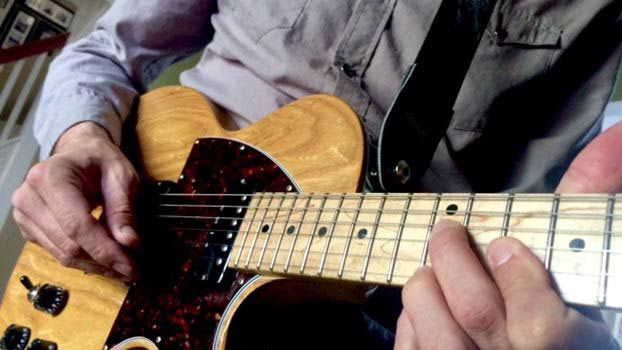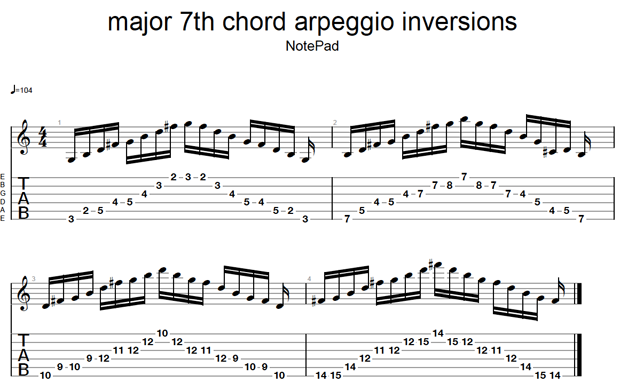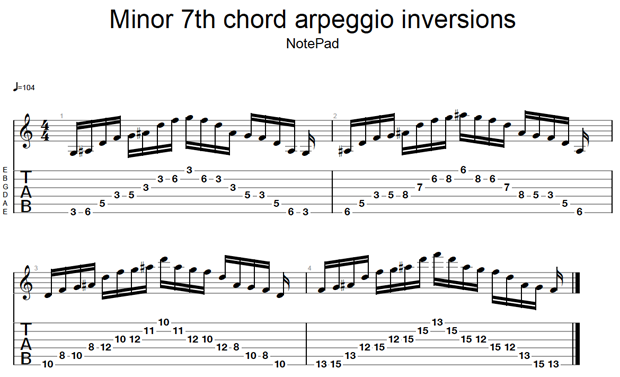An Introduction to Arpeggio Inversions
Arpeggio inversions are quite useful, and will help you improve your fretboard vision.

Hey, everyone! In the past few blog posts, I've been discussing various arpeggio exercises in order to show you how notes on the fretboard are connected, and also how to master the fretboard.
In this column, I'd like to continue the arpeggio discourse but also really challenge you by taking it up a notch. I present arpeggio inversions!
First things first, however. We need to define inversion. An inversion is a chord or arpeggio that doesn't begin on the root note. For example, in a C major 7th chord (C, E, G,B), if we play the chord or arpeggio starting on the root note, the C, that would be considered the root position.
But if we start the chord on the E, which is the second note of the triad and the third note of the C major scale, that would be considered first inversion.
If we start the chord or arpeggio on the G, which is the third note of the triad and the fifth note of the C major scale, that would be considered second inversion. Finally, if we start the chord or arpeggio on the B, which is the third note of the triad and the seventh note of the C major scale, that would be considered third inversion.
The lowest note of the chord or arpeggio will always determine which inversion is defined. Or, as my old theory professor, Dr. Austin, would say, "Richard, the bass is boss." This is true of all major, minor, dominant and diminished chords and inversions. You will notice that in all of my past columns on this subject, the arpeggios started on the root note of the chord we were arpeggiating. That will change as of now.
The following two exercises are a G major arpeggio (G, B, D, F#) and a G minor arpeggio (G, Bb, D, F), respectively. For both exercises, the first measure is root position, the second measure is first inversion, the third measure is second inversion and the fourth measure is third inversion.


As always, these forms are moveable, so they will work in all keys with the root on the sixth string. So move them around and incorporate them into your lead work. This exercise also will increase your knowledge of how the notes fit together on the fretboard. This is a very challenging and demanding exercise to play and master — especially cleanly and quickly with a metronome — but I know you guys are up for it!
Now let's get out there and pick up that guitar and play just like yesterday. As always, any feedback and comments are always welcome. Thanks for reading.
Guitarist Richard Rossicone is a veteran of the New York City and Long Island original and cover band scene. He's been playing since he was 8, when he attended his first concert (Kiss) and saw Pete Townshend smash a guitar. He has studied with various instructors over the years, which led him to a career in music therapy. He began his educational journey at Queensboro Community College, where the faculty introducing him to classical music. He received his associate's degree in fine arts in 1997 and went on to receive his bachelor's in music therapy in 2001 and his master's in music therapy from New York University in 2004. He's been Board Certified as a music therapist since 2002. Richard continued his studies at C.W. Post University, pursuing a second master's degree in classical guitar performance and music history, studying under Harris Becker. He's been teaching guitar, piano and theory since 2002 and in 2006 started his own company, Rossicone Music Studios. Visit him at Axgrinder.com and his Complete Guitarist Facebook page.
Get The Pick Newsletter
All the latest guitar news, interviews, lessons, reviews, deals and more, direct to your inbox!









![Joe Bonamassa [left] wears a deep blue suit and polka-dotted shirt and plays his green refin Strat; the late Irish blues legend Rory Gallagher [right] screams and inflicts some punishment on his heavily worn number one Stratocaster.](https://cdn.mos.cms.futurecdn.net/cw28h7UBcTVfTLs7p7eiLe.jpg)
